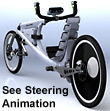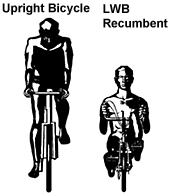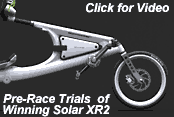



XR2 HP




RACE IMAGES











|
|
|
Order Online
- or -
by Phone, Fax, or Mail
CD-ROM Includes...
 3D models
of 3D models
of
individual parts &
assemblies.
 Complete set of 2D Complete set of 2D
CAD drawings
viewable on
computer & in PDF
format for full-size
printing.
 In-depth manual In-depth manual
with large high-
resolution photos &
links to on-line
services & vendors.
 Files for making Files for making
decals & logos.
 Links to free 2D & Links to free 2D &
3D CAD viewers.
 High-resolution High-resolution
Race, first-ride &
pre-race practice
videos.
IMPORTANT
Mac users, please
see "Important Notice" below and to the right in the
body text.
|
Price...
$75
+ Shipping & Handling
(Shipping charge is calculated at the time of purchase & varies
according to destination)


|
|
|
|
|

|
Jump to:
About the
Plans - Championship Solar XR2
& Video - Specifications - Interviews & Reviews
  There
are few times when a designer has the opportunity to pull out the stops
and create an advanced, race-winning design like the new Ground
Hugger XR2 HP. This new HP (High Performance)
machine leapfrogs ahead of anything available anywhere in the world to
raise the bar on recumbent bicycle design and deliver an unparalleled
sense of excitement and pleasure to your cycling experience. Its
unique architecture
provides for three versions from a single design: There
are few times when a designer has the opportunity to pull out the stops
and create an advanced, race-winning design like the new Ground
Hugger XR2 HP. This new HP (High Performance)
machine leapfrogs ahead of anything available anywhere in the world to
raise the bar on recumbent bicycle design and deliver an unparalleled
sense of excitement and pleasure to your cycling experience. Its
unique architecture
provides for three versions from a single design:
Three Optional Versions
Break Free of the
Gas Pump
With today's soaring fuel costs, it's about time to break free of the
gas pump and enjoy clean and virtually free mobility. You can
slash high commuting costs and smell the roses in the process, and do it
without the pedal-pumping work of a conventional bicycle. With its
combination of battery-electric and solar capabilities, the Ground
Hugger XR2 HP offers a new way to cut monthly expenses and have fun
doing it. With either of the two
electric power systems, you can select the amount of necessary
pedal power. Or you can stop pedaling altogether and cycle
on battery power with assistance from solar power. On a sunny day,
solar power can maintain up to 8 km/hr with little or no drain on the
batteries.
Ground Hugger XR2
HP
Based on a Proven Track Record
 Major advances in the
first release included a carbon fiber composite seat and frame, a rear
suspension system ("soft-tail"), and the latest in cycling components,
along with its characteristic steering system. In terms of
esthetic design, the Ground Hugger XR2 broke new ground by making a
uniquely independent statement of its own. We call it our Ferrari on two
wheels. Major advances in the
first release included a carbon fiber composite seat and frame, a rear
suspension system ("soft-tail"), and the latest in cycling components,
along with its characteristic steering system. In terms of
esthetic design, the Ground Hugger XR2 broke new ground by making a
uniquely independent statement of its own. We call it our Ferrari on two
wheels.
With this new HP release,
you receive an upgraded frame with improved strength and ascetics.
You also get
improved steering geometry engineered around the ISO 406-28 mm front
wheel and 20x1.1 high-pressure tire, a breakthrough in
steering system design for superior control, and optional battery-electric
and solar power. The
tastefully integrated on-board photovoltaic panels can stretch out range
and recharge batteries while you're parked. Or
simply leave off the electric power system to create the most advanced
human-powered recumbent on the planet.
Unique Steering System
 The
XR2's characteristic steering system has to be experienced in order to be fully appreciated. It's
part
of the matrix that gives the XR2 its graceful appearance and superior
control. Improvements on this HP release add a new
dimension to the system's feel of the road and stable performance. And it solves a problem
that has plagued recumbent bicycle designers since the beginning - the
long reach to the front wheel. The
XR2's characteristic steering system has to be experienced in order to be fully appreciated. It's
part
of the matrix that gives the XR2 its graceful appearance and superior
control. Improvements on this HP release add a new
dimension to the system's feel of the road and stable performance. And it solves a problem
that has plagued recumbent bicycle designers since the beginning - the
long reach to the front wheel.
 Long wheelbase (LWB) recumbent bicycles allow designers to
take full advantage of the small frontal area made possible with a low, sleek
layout. But it introduces the problem of how to steer the front wheel
when it's located out in front of the rider's feet. Short wheelbase (SWB)
recumbent layouts locate the front wheel approximately underneath the
rider's knees, which shortens the reach to the front wheel but it does
not fully solve the problem. Tiller, under-seat, and
laid-back-handlebar steering often result in compromised steering
geometry or an awkward steering layout, or both. The XR2's
steering system produces a comfortable and intuitive system with a
rock-solid feel of the road that is unmatched by previous designs. Long wheelbase (LWB) recumbent bicycles allow designers to
take full advantage of the small frontal area made possible with a low, sleek
layout. But it introduces the problem of how to steer the front wheel
when it's located out in front of the rider's feet. Short wheelbase (SWB)
recumbent layouts locate the front wheel approximately underneath the
rider's knees, which shortens the reach to the front wheel but it does
not fully solve the problem. Tiller, under-seat, and
laid-back-handlebar steering often result in compromised steering
geometry or an awkward steering layout, or both. The XR2's
steering system produces a comfortable and intuitive system with a
rock-solid feel of the road that is unmatched by previous designs.
Winner in Category of Australian World Solar Cycle Challenge
 A team at
Prince Alfred College in Australia, under the leadership of Professor
Paul A team at
Prince Alfred College in Australia, under the leadership of Professor
Paul
 Balestrin, built a solar assist version of the first Ground Hugger
XR2 and entered the 2001 Australian World Solar Cycle Challenge.
The Solar XR2 took first place in "B-Class" and third place overall.
B-Class is a category for unfaired recumbents; machines having no
aerodynamic body to reduce drag. Average speed over the 1553 km
course was 41.1 km/h. Top speed was 65km/h on a level run. This
new release includes plans for an upgraded and refined version of the
race-winning Solar XR2.
Click here for more information
on the winning machine built at Prince Alfred
College. Plans show an upgraded electrical system with greater
collection area and Lithium-Ion batteries. Balestrin, built a solar assist version of the first Ground Hugger
XR2 and entered the 2001 Australian World Solar Cycle Challenge.
The Solar XR2 took first place in "B-Class" and third place overall.
B-Class is a category for unfaired recumbents; machines having no
aerodynamic body to reduce drag. Average speed over the 1553 km
course was 41.1 km/h. Top speed was 65km/h on a level run. This
new release includes plans for an upgraded and refined version of the
race-winning Solar XR2.
Click here for more information
on the winning machine built at Prince Alfred
College. Plans show an upgraded electrical system with greater
collection area and Lithium-Ion batteries.
Carbon Fiber Construction
The frame and seat are built of hand-laid carbon fiber
over a urethane foam core. The molds
and vacuum bagging typical of conventional carbon fiber construction are
unnecessary. We've used vinylester resin, which is about half the price and nearly
as strong as conventional epoxy. The main advantage of vinylester is that it's
catalyzed and applied just like polyester resin, which makes it much easier to use for the
do-it-yourselfer.
Lay-ups are applied to the urethane foam core, and the foam remains as an integral part
of the frame. So the foam serves as a mold and it adds significantly to
the strength of the frame. Imagine bending a hollow metal tube to the point where it
kinks and collapses. The same failure point occurs with any hollow structure,
regardless of the material. But with a foam core, the walls of the structure (the
carbon fiber skin) are held in place so they cannot kink and collapse. Even though
the foam has little strength of its own, it plays an important role in the overall
strength of the composite structure.
Metal fixtures are laminated in place
at attachment points, such as the head, bottom brackets (there are two),
steering tube, and rear suspension hardpoints. The bottom bracket
shells are purchased ready-made, and the other items are simply cut from
lengths of aluminum tubing. The photo of the foam core (in the
left margin) shows the aluminum steering housing cemented in place.
Plans provide instructions for eliminating the electrolysis that
sometimes happens between carbon fiber and bonded-in metal parts.
Table T1 provides a listing of materials and
the cost to build the seat and frame
(exclusive of finishing materials). Due to the abundant
choice of components, the three optional power systems, and builder
preferences in components, a complete cost to build has not been
estimated. Consider that building the XR2 HP is mainly a frame
building and assembly project, and equipment choices are mostly within
the control of the builder.
| Table T1 |
Frame and Seat Materials |
| Carbon Fiber Cloth |
3.5 yrd |
$122.50 |
| Vinylester Resin |
1 gal |
$ 35.00 |
| Urethane Foam* |
4 x 8 ft x 2.5 inch |
$ 65.00 |
| Steering Housing |
25 inch of 1.5 OD x 0.035 T6 alum. |
$ 25.00 |
| Tandem BB Shells (2) |
|
$ 50.00 |
|
Total |
$297.50 |
| *Enough
foam for three bicycles. Normally sold only in 4 x 8 ft
sheets. |
Specifications
Table T2 provides the weight of a few of the XR2's primary components.
Specifications are provided in the Table T3.
| Table T2 |
Weight of Primary
Components
(One ounce = 28.3
grams) |
| Frame* |
6 lb 6
oz |
| Steering Tube** |
1 lb 8
oz |
| Fork Assembly |
1 lb 0.02 oz |
| Chain Stay Assembly |
1 lb 14 oz |
| Seat |
1 lb 10 oz |
| Front Wheel |
3 lb 7 oz
(Aerospoke carbon fiber wheel with tire) |
| Rear Wheel***
|
5
lb 8 oz (Aerospoke carbon fiber wheel with tire and 9-spd.
cassette) |
| Bottom Bracket |
8.8 oz ea. (two required) |
|
|
*Includes 1-3/4 lbs of filler/surfacer and paint.
Frame may be natural-finished for weight savings.
**Cab be reduced to approximately 10 - 14 oz
by drilling lightening holes shown in the plans.
***An alternative 36-spoke rear wheel equipped with an identical tire, an aluminum
rim, the Sachs 3 x 7 internal hub, and a 7-spd cassette weighted precisely the same. |
Table T3 |
Specifications |
Length:
Height:
Wheelbase:
Weight:
Front Wheel:
Rear Wheel:
Gearing:
Brakes:
Rear Sus.
Seat Adj. |
90 inch (2285.7 mm)
36 inch (914.4 mm to top of handlebars)
67.9 inch (1725 mm)
27 - 45 lbs (depending on frame finish and components)
20 x 1.1 (406-28mm rim with 20.1 tire)
26 - 27 inch (optional cross-section)
Optional (R derailleur or Sachs 3 x 7 internal hub)
Optional disc
Trailing arm with air/spring shock
4-inch (101.6mm) longitudinal seat & 6-inch (152.4mm) handlebar adjustment
(Fits 64 - 72 inch/1625.6 - 1828.8mm rider height as shown. Frame may be shortened or
lengthened for taller or shorter riders.) |
|
About the Plans
 Plans
are written with the assumption that you have no previous experience
with bicycles or composite construction. We call it "information
overkill." And you will be pleasantly surprised to see how DIY
instructions and
modern CAD system technologies have been integrated in such a user friendly way.
This type of presentation was developed especially for the DIY field.
If you can browse a Website, you'll be at home with the advanced
three-dimensional presentations on the CD-ROM. And it's an ideal way
to spark interest in students for professional-level 3D design and
engineering technologies. Modern 3D CAD systems are a little like
video games, except they deal with the real world and produce real
results. This DIY presentation provides a
sense of what modern design technologies are all about. Plans
are written with the assumption that you have no previous experience
with bicycles or composite construction. We call it "information
overkill." And you will be pleasantly surprised to see how DIY
instructions and
modern CAD system technologies have been integrated in such a user friendly way.
This type of presentation was developed especially for the DIY field.
If you can browse a Website, you'll be at home with the advanced
three-dimensional presentations on the CD-ROM. And it's an ideal way
to spark interest in students for professional-level 3D design and
engineering technologies. Modern 3D CAD systems are a little like
video games, except they deal with the real world and produce real
results. This DIY presentation provides a
sense of what modern design technologies are all about.
The disc includes 3D electronic models
that let you zoom, pan, and rotate CAD-accurate electronic models.
You can
even take dimensions in three-dimensional space. Conventional 2D
CAD drawings are also included, but the most enjoyable and enlightening
experience will be with the 3D models. Within an assembly, you can export
individual parts into separate documents, make cutaway views by
simply dragging a plane across a part or an assembly, and change transparency
with the click of a mouse so
you can see what's inside.
An in-depth manual, which runs in a
web browser, provides detailed
instructions and
click-to-enlarge images of parts and assemblies at various stages of
construction. You can enjoy still images and video clips of the
Ground Hugger XR2 HP in action. The CD-ROM contains a professionally produced video of the 2001 Australian World
Solar Cycle Challenge.
You'll see the Solar XR2 cross the finish line and enjoy interviews with
other participants. And you'll have direct links to vendors on the
Internet.
The CD-ROM is designed for an ordinary Windows PC, but it will also run on Macintosh OS-X machines (see
"Important Notice" below). Links for downloading free CAD
viewers are included on the disc. You do not need a CAD system to
view the electronic CAD drawings and 3D models.
The presentation on
disc contains complete information, including printable drawings and a
printable copy of the manual. If desired, you can order
printed drawings and a printed and bound manual from us. Or a local printer can
make full-size prints from the PDF copies on the disc. The
electronic manual
on disc is identical to the printed version, with one exception. A
printed manual cannot provide high-resolution images that are larger
than the printed page, nor animations, videos, and Internet inactivity.
Both, however, include complete construction and assembly details, technical and
design information, a list of vendors, and a materials list.
|
Important Notice
The CD-ROM is designed for Windows, but it will also run on
Macintosh OS-X systems. The CD-ROM is written in
HTML and designed to run in a web browser. A link to a free viewer
in both Macintosh and PC formats is provided on the CD-ROM.
The 3D programs work best, however, when running on a PC in a
Windows environment. Native CAD files were created in SolidWorks. |
Interviews and Reviews
-
BikeRod&Kustom During an
interview with Jim Wilson, Webzine Editor of BikeRod&Kustom, Robert Q. Riley
talks about the development and design details of the XR2. In a separate article,
Jim Wilson reviews the XR2 plans.
|
|